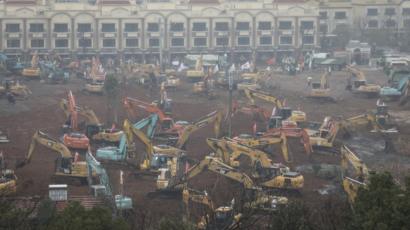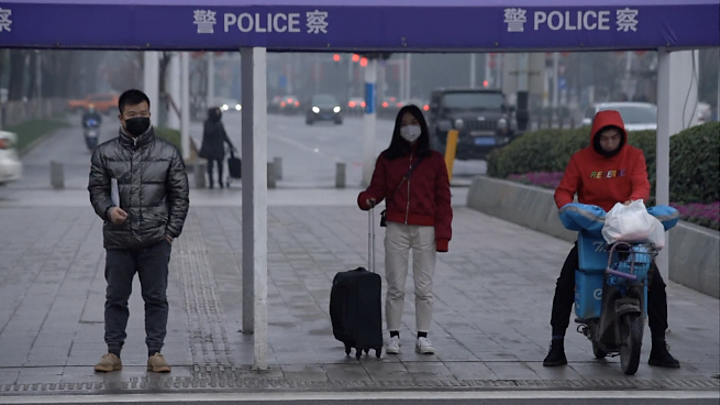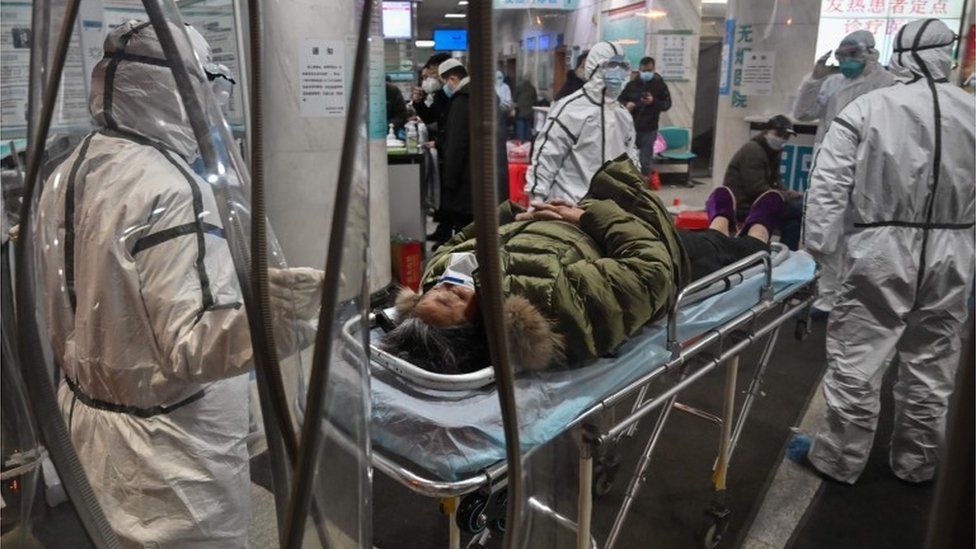China coronavirus spread is accelerating, Xi Jinping warns
Share this with EmailShare this with FacebookShare this with TwitterShare this with Whatsapp
Video caption What's life like in quarantined Wuhan?
The spread of a deadly new virus is accelerating, Chinese President Xi Jinping warned, after holding a special government meeting on the Lunar New Year public holiday.
The country is facing a "grave situation" Mr Xi told senior officials, according to state television.
The coronavirus has killed at least 41 people and infected almost 1,300 since its discovery in the city of Wuhan.
Travel restrictions have already hit several affected cities.
And from Sunday, private vehicles will be banned from central districts of Wuhan, the source of the outbreak.
A second emergency hospital is to be built there within weeks to handle 1,300 new patients, and will be finished in half a month, state newspaper the People's Daily said. It is the second such rapid construction project: work on another 1,000-bed hospital has already begun.
Specialist military medical teams have also been flown into Hubei province, where Wuhan is located.
The urgency reflects concern both within China and elsewhere about the virus which first appeared in December.
Lunar New Year celebrations for the year of the rat, which began on Saturday, have been cancelled in many Chinese cities.
Across mainland China, travellers are having their temperatures checked for signs of fever, and train stations have been shut in several cities.
In Hong Kong, the highest level of emergency has been declared and school holidays extended.
Several other nations are each dealing with a handful of cases, with patients being treated in isolation.
What is the coronavirus, and what does it do?
A coronavirus is a family of viruses which include the common cold.
But this virus has never been seen before, so it's been called 2019-nCov, for "novel coronavirus".
New viruses can become common in humans after jumping across the species barrier from animals.
The Sars [Severe Acute Respiratory Syndrome] outbreak of 2003 started in bats and transferred to the civet cat which passed it on to humans.
Image caption Queues have been growing at hospitals in Wuhan
This new virus also causes severe acute respiratory infection.
Symptoms seem to start with a fever, followed by a dry cough and then, after a week, lead to shortness of breath and some patients needing hospital treatment.
There is no specific cure or vaccine.
Based on early information, it is believed that only a quarter of infected cases are "severe", and the dead are mostly - though not exclusively - older people, some of whom have pre-existing conditions.
The Chinese authorities suspect a seafood market that "conducted illegal transactions of wild animals" was the source of the outbreak.
What's happening at the source?
The city of Wuhan is effectively on lockdown, with heavy restrictions on travel in and out, and public transport options from buses to planes cancelled.
It is a major population centre with up to 11 million inhabitants - comparable in size to London.
Pharmacies in the city have begun to run out of supplies and hospitals have been filled with nervous members of the public.
Officials have urged people to avoid crowds and gatherings.
"The whole transport system has been shut down," Kathleen Bell, who is is originally from the UK and works in Wuhan, told the BBC. "From midnight tonight private cars are not allowed on the road. And taxis aren't running."
Major Western brands such as McDonald's and Starbucks have closed in the city and in others nearby.
The US, France and Russia are among several countries trying to evacuate their nationals from Wuhan, reports say.
Video caption WHO regional director says China now has "stronger capacity" to deal with infectious outbreaks
The surrounding Hubei province is also deeply affected, with nearly a dozen cities enduring some sort of travel restriction.
Where has it spread?
There are now nearly 1,300 confirmed cases all across China, though most concentrated in those closest to Hubei.
But it has also spread abroad - in isolated cases affecting small numbers of patients.
On Saturday, Australia confirmed its first four cases - first in Melbourne, and then three more in Sydney.
It has also spread to Europe, with three cases confirmed in France.
Tests in the UK on 31 people have come back negative , the government has said. Officials are trying to trace around 2,000 people who have recently flown to the UK from Hubei province.
The cases largely involve people who had recently travelled from the affected region in China.
China's neighbours in the Asia region are on high alert, however, with cases reported in Thailand, Singapore, Japan, Taiwan, Malaysia, Vietnam, South Korea and Nepal.
There are also cases in the United States.
The World Health Organization has not classed the virus as an "international emergency", partly because of the low number of overseas cases.
What is the impact on new year celebrations?
The Lunar New Year is one of the most important dates in the calendar in China, where millions of people travel home - something that is a problem for preventing the spread of a virus.
Authorities have shut major tourist sites including the Forbidden City in Beijing and a section of the Great Wall, and cancelled major public events in other parts of the country, including:
- Traditional temple fairs in Beijing
- An international carnival in Hong Kong
- Hong Kong's annual football tournament
- All public Lunar New Year celebrations in Macau
Shanghai's Disney Resort is temporarily closing.
In the capital, Beijing, and also in Shanghai, officials have asked residents who return from affected areas to stay at home for 14 days to prevent the spread of the virus, local media report.








